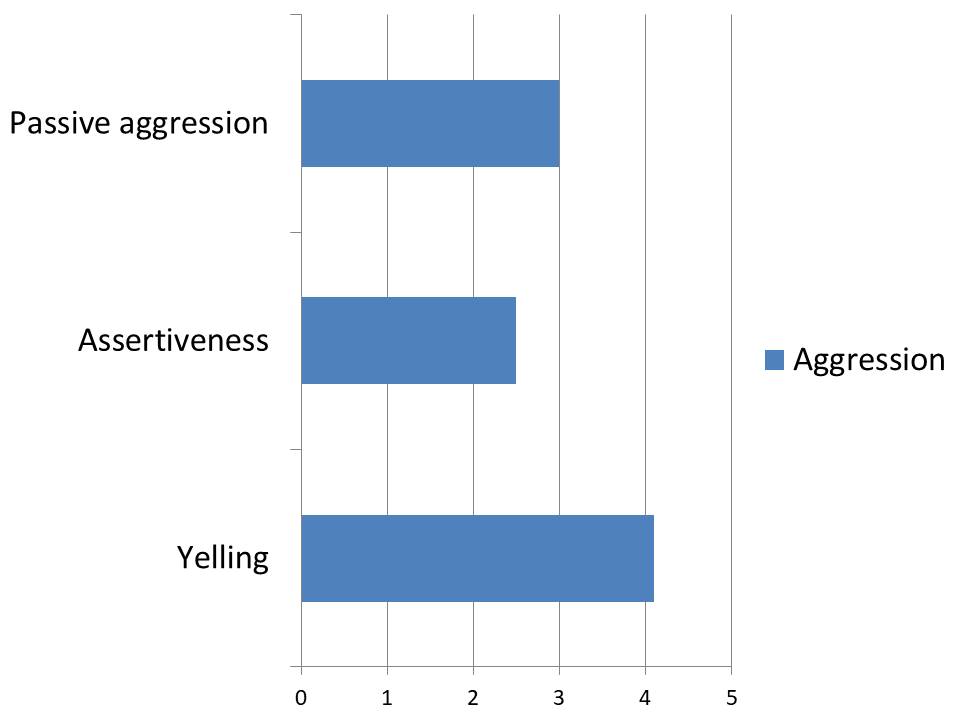A passive-aggressive person is one who tends to adopt a passive-aggressive communication style. When someone’s rights are stepped on or when their goals are frustrated by others, they can either behave:
- Passively = Do nothing
- Aggressively = Get their rights back by stepping on others’ rights
- Passive-aggressively = Indirect aggression
- Assertively = Get their rights back without stepping on the rights of others
Both passive-aggression and assertiveness lie in the middle ground between passivity and aggression, the two extremes, but they differ in a key aspect.
While assertiveness ensures the rights and needs of the other person are safeguarded, passive aggression doesn’t.
Passive aggression is indirect aggression. Passive-aggressive people violate the needs and rights of others indirectly. It’s a weak form of aggression, but it’s still aggression.
Examples of passive-aggressive behavior
The following examples will clarify what it means to be passive-aggressive:
Agreeing, and then switching
Passive-aggressive people think confrontation equals aggression, and they have no concept of assertiveness. If you ask them to do something, they’ll not say “No” to avoid directly offending you (Aggression). But they also won’t do the task they agreed to do (Passive aggression).
This way, they succeed in both not offending you and, ultimately, having their own way. Often, when you find they haven’t done the thing, it’s too late to confront them. You figure it’s better to put out the fire yourself than waste time confronting them.
“I’m fine” or “It’s okay”
When someone says “I’m fine” or “It’s okay” but their metacommunication (tone, body language, etc.) communicates otherwise, they’re being passively aggressive. They’re pissed at you but aren’t communicating it directly through their words.
Deliberate forgetting
This is related to agreeing and then switching, the difference being that the person comes up with a justifiable excuse, in this case- forgetting.
When people say they forgot to do something, it’s a believable excuse because humans are prone to forgetting.
But when it comes from a person who’s usually not that forgetful or simply couldn’t have forgotten the task given its importance, chances are high it’s deliberate forgetting.
Another form such passive-aggressive behavior takes is leaving things half-done or leaving some things undone. When people don’t want to do the work they’ve been tasked with, they might leave it half-done. This is, again, an indirect way to express hostility and resentment.
Deliberate mistakes
An employee who’s given a task they’re not willing to do might commit intentional mistakes to ruin the project if they can do so without serious consequences. It’s usually a passive-aggressive attempt to ensure they’re not given the same tasks again.
Back-handed compliments
A backhanded compliment is an insult disguised as a compliment to take the edge off of the insult and make it less direct.
For example, saying something like “Your work was surprisingly good” implies that it’s often not good. And saying “You look beautiful today” to someone implies they don’t look good on other days.
Note here that passive aggression is all about intent. It may be that someone says, “You look beautiful today” with no intention of hiding an insult. It might be that you’re particularly well-dressed today. You paid more attention to the word “today” while they slipped it in their compliment unthinkingly.
Silence and withdrawal
This is perhaps the most common form of passive aggression in relationships. People who’re close to us naturally want to engage with us. Withdrawal and silent treatment conveys “I’m mad at you” without being directly aggressive.
Why do people behave passive-aggressively
As you’ve seen, people behave passive-aggressively when they want to show aggression indirectly. They can’t show direct aggression for fear of offending others to their face. Yet, they don’t want to be passive at the same time.
Passive aggression is often a response to perceived or real injustice. Passive aggressive behavior usually comes from people close to us because they’re the ones who care about not offending us directly the most.
The goal of passive-aggressive behavior is to send this message across to the other person:
“Ultimately, my needs and wants shall prevail over yours.”
It’s a win-lose orientation where the passive-aggressive person is trying to score a point over the other person.
Passive-aggressive behavior is annoying, and it’s natural to want to annoy passive-aggressive people back. The way to annoy a passive-aggressive person is to frustrate their goal.
Often, people respond to passive aggression with aggression, which brings immense satisfaction to the passive-aggressive person. It tells them that their strategy to piss you off covertly worked. As a result, it only reinforces their behavior.
The next section will discuss how to annoy a passive-aggressive person effectively.
Ways to annoy passive-aggressive people
1. Confrontation
Assertive, not aggressive, confrontation is the best way to frustrate the goals of a passive-aggressive person. You see, passive-aggressive people hate confrontation. It’s not their style.
When you catch them in the moment and stand up for yourself assertively, you catch them off guard. You’ve blown their cover and exposed their naked hostility. This forces them to change their style and be more direct.
For example, instead of reacting with silence or “Thank you” to the comment, “Your work was surprisingly good”, you can respond by calmly saying, “So it’s usually not good?”
This way, you’ve exposed them, and they’re forced to retreat because they don’t want confrontation.
Rarely, you’ll find someone saying, “Yes, usually it’s bad”. That’s direct aggression, and the person who can say a thing like that wouldn’t need to be passive-aggressive in the first place.
Here’s why aggressive confrontation doesn’t work:
As mentioned earlier, it signals success to them. It means they were successful in getting under your skin. An aggressive response also makes you look bad because your response seems disproportionate to their weaker, more passive aggression.
To make things worse, they can add salt to the wound by saying something like, “Calm down! Why are you getting all worked up?” knowing full well that their goal was to indeed get you all worked up.
Imagine responding to “Your work was surprisingly good” by yelling back:
“WHAT DO YOU MEAN SURPRISINGLY GOOD?”
See the difference? Sticking to assertiveness is often the best strategy.

2. Exposing motives
This goes one step beyond assertive confrontation. You basically tell them why they’re doing what they’re doing. The beauty of this strategy is that you get to be as confrontational as possible without being aggressive.
For example, replying to the passive-aggressive “I’m fine” with something like:
“You know what: You don’t have to do that. You can tell me you’re not fine when you’re not.”
This not only exposes their operations but also their motives. When motives are exposed, you can’t make the person feel more naked.
If you’re an employer, you can confront the employee who leaves work half-done by saying something like:
“If you didn’t want to do it, you could’ve told me. I’d have done it myself.”
When you confront at the level of motives, you signal to them that their passive-aggressive ‘game’ will not work on you.
3. Tit-for-tat
Passive-aggressive behavior often succeeds in annoying us. The problem is: We can’t overtly express our annoyance in most cases. Instead, we can play the same game back at them: We can respond to passive aggression with passive aggression.
The upside of this strategy, when executed well, is that it’s a variation of exposing their motives technique. By playing the same game back at them, you show them how ridiculous they’re being.
It also forces them to put themselves in your shoes and make them realize how annoying their passive aggression must be to you.
The key in executing this strategy well is being passive-aggressive to them in the same manner in which they’ve been passive-aggressive to you.
For example, if they throw backhanded compliments at you, you do it too. If they say, “I’m fine” you say that too when you’re mad, making sure your tone and body language communicate otherwise, of course.
The only downside of this technique is that you’ll give them a tinge of satisfaction that their passive aggression worked. If it hadn’t, you wouldn’t be compelled to hit back passive aggressively.
Still, the benefits of annoying them back this way might outweigh any satisfaction that they can get out of it. It kind of forces them into a corner. If they hit back again, you can be satisfied that your counter-strategy worked.
I recommend stopping at this point because you don’t want to go down the endless spiral of passive-aggressive tit-for-tats. If you come to this point, you’ve probably taught them the lesson by now.
4. Non-reaction
Not reacting to passive-aggressive behavior in any shape or form is the surest way to annoy a passive-aggressive person. While it may be effective in pissing them off, it’s not so good for your own mental health.
Thing is, passive aggression does get under our skin, especially when it comes from people we care about. If we don’t react to it at all, we do teach them that their passive aggression isn’t working.
But, the problem with this passive strategy is that the hurt will keep building up. You may put on a calm and non-reactive face for a time. But if they continue to be passively aggressive, you’re likely to cave in and crack under the pressure, resorting to aggression.
This strategy requires a lot of inner work to successfully pull off. You need to have attained a certain level of mastery over your emotions.

